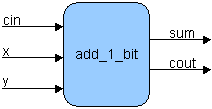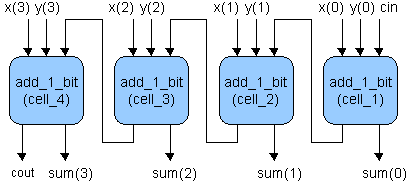|
How-to Easily Design an
Adder Using VHDL
Preface
We are going to take a look at designing
a simple unsigned adder circuit in VHDL through different
coding styles. By doing so, this will get you familiar with
designing by different methods and, hopefully, show you to
look for the easy solution before attempting to code
anything.
The specific circuit we are
going to model in this how-to is a 4-bit unsigned adder. In
the first pass of the design, we will build a 1-bit full adder
(or (3,2) counter) slice that will be used to build the full
4-bit adder. In the second pass of the design, we are going to
build the circuit using the IEEE std_logic unsigned package, a
much more code efficient and scalable design.
This how-to assumes you have
some knowledge of VHDL and understand concepts such as
entities, architectures, and signals. If you need further VHDL
language references, please check under the tutorials section
of Student Resources. Let begin!
1-Bit Full
Adder
As you know, a
1-bit full adder is characterized by the following
equations:
sum = x xor y xor
cin
cout = (x and y) or (x and cin)
or (x and cout)
where x, y, and cin
are the two inputs and the carry in, respectively while sum
and cout are the sum and carry out. A pictorial representation
of the component is listed in figure 1.

Figure 1 - 1-Bit Full Adder
Component
The VHDL code for the
above component (downloadable file add_1_bit.vhd)
is as follows:
library
IEEE;
use IEEE.std_logic_1164.all;
entity add_1_bit
is
port (
x: in std_logic;
y: in std_logic;
cin: in std_logic;
sum: out std_logic;
cout: out std_logic
);
end add_1_bit;
architecture rtl of
add_1_bit is
begin
sum <= x xor y xor cin;
cout <= (x and y) or (x
and cin) or (y and
cin);
end rtl;
As you can see, we are using
the standard IEEE libraries, which include std_logic, in order
to create components that can be synthesized easily to
hardware. Using signal types such as bit may not synthesize or produce
unpredictable results. Always use the std_logic_1164
library!
This is a pretty standard
component. In the entity declaration, x, y, and cin are
declared as inputs of type std_logic. The outputs are sum and
cout of type std_logic. In the architecture section, we define
the outputs sum and cout to be concurrent statements based
directly off the inputs. Nothing special about this component,
I'm sure you have already seen a version of this
model.
4-Bit Unsigned Adder using 1-Bit
Full Adder Component
Now
we are going to make four copies of the above component to
make our 4-bit unsigned adder component, thus producing a
ripple-carry adder. This is done through instantiating four
copies of the above 1-bit adder component in VHDL. Figure 2
illustrates the connections of this
component.

Figure 2 - 4-Bit Unsigned
Adder
The inputs to the
component are the 4-bit unsigned numbers, x and y, and the
carry in that includes cin and the internal ripple carries
between each 1-bit block. The 4-bit output sum and cout are
shown as outputs of the systems. Listed below is the VHDL code
for the component (downloadable add_4_bits.vhd).
library
IEEE;
use IEEE.std_logic_1164.all;
entity
add_4_bits is
port
(
x: in
std_logic_vector(3 downto 0);
y: in
std_logic_vector(3 downto 0);
cin: in std_logic;
sum: out
std_logic_vector(3 downto 0);
cout: out std_logic
);
end add_4_bits;
architecture rtl of
add_4_bits is
component add_1_bit
port
(
x: in
std_logic;
y: in
std_logic;
cin: in
std_logic;
sum: out
std_logic;
cout: out
std_logic
);
end component;
signal i_carry:
std_logic_vector(2 downto 0);
begin
cell_1:
add_1_bit
port map
(x(0), y(0), cin, sum(0), i_carry(0));
cell_2: add_1_bit
port map (x(1), y(1),
i_carry(0), sum(1), i_carry(1));
cell_3: add_1_bit
port map (x(2), y(2),
i_carry(1), sum(2), i_carry(2));
cell_4: add_1_bit
port map (x(3), y(3),
i_carry(2), sum(3), cout);
end rtl;
You can see that we
define the component add_1_bit in the architecture declaration
section of the code. Please also notice that this declaration
follows VHDL-87 format and NOT the '93 version. This is
because the synopsis synthesis tool is VHDL-87 compliant and
we need to code to those rules in order to generate valid
synthesis results. Coding in '93 will not (currently) work.
Four versions of
this component are then declared in the body section of the
code, with all of the appropriate "glue" between each
component. As this point, you must be asking, "isn't there an
easy way to do this?". From my perspective, this is alot of
code for just a 4-bit unsigned adder; the point to VHDL is to
make it easier to perform operations such as the above. Let's
take alook at an easier way.
4-Bit Unsigned
Adder Using std_logic_unsigned
Using the same entity as above, look at
the code below and notice how much and where it has been
shortened (downloadable add.vhd).
library
IEEE;
use IEEE.std_logic_1164.all;
use IEEE.std_logic_unsigned.all;
entity
add is
generic (width:
integer:=4);
port (
x: in
std_logic_vector((width-1) downto
0);
y: in
std_logic_vector((width-1) downto 0);
cin: in std_logic;
sum: out
std_logic_vector((width - 1) downto 0);
cout: out std_logic
);
end add;
architecture rtl of add is
signal i_sum:
std_logic_vector(width downto 0);
constant i_cin_ext:
std_logic_vector(width downto 1) := (others => '0');
begin
i_sum <=
('0' & x) + ('0' & y) + (i_cin_ext & cin);
sum <= i_sum((width-1) downto
0);
cout <= i_sum(width);
end rtl;
The first thing you
will notice, at the top of the code, is the reference to the
std_logic_unsigned package, used for unsigned std_logic
arithmetic operations. This package contains a procedure
called "+" which we use as an addition within the body of the
architecture. This "+" takes three unsigned std_logic_vectors
and adds them, returning a result.
The other should be
the use of a generic. A generic lets us produce code that can
be changed by the passed parameter. In our case, we let the
generic width be the bit width of
the two numerands, thus making the code scalable to any width
of signals.
For this specific
example, we take x and y, concatenate a '0' to the beginning
(unsigned logic). For cin, we concatenate a vector one less
than the generic constant. These are all added with "+" and
assigned to the result i_sum. We then split i_sum into the sum
and the carry out. This can be done a number of ways but this
is one of them and, as you can see, is much simpler than the
previous example. Additionally, with the use the generic width, the component becomes much more
reusable, a quality always desired by designers.
I have found that
the performance of such code to be better, while easier to
code, than other algorithmic techniques. This is probably due
to the fact that the synthesis tools will understand what is
inferred by the IEEE libraries more than any algorithm you can
write. However, be careful of the cin vector. Good synthesis
tools will recognize that the cin vector is really only cin
padded with zeros, and thus will apply only the cin signal to
the input of the cin portion of the fast carry logic for the
FPGA. However, others will not; check the output of the
synthesis tool to make sure that the fast carry logic was used
on the FPGA (assuming such logic exists). Of course performing
hand layout methods or using LogicBLOX will produce smaller,
faster results. But those methods become technology dependent
(i.e. tied to your target device) while this code will
not.
fouldsbr@msu.edu |